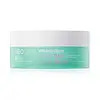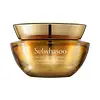What's inside
What's inside
 Key Ingredients
Key Ingredients

 Benefits
Benefits

 Concerns
Concerns

 Ingredients Side-by-side
Ingredients Side-by-side

Water
Skin ConditioningHydrogenated Olive Oil Lauryl Esters
Emulsion StabilisingCetyl Ethylhexanoate
Emollient1,2-Hexanediol
Skin ConditioningGlycerin
HumectantNeopentyl Glycol Diheptanoate
EmollientCamellia Sinensis Leaf Extract
AntimicrobialAscorbic Acid
AntioxidantCyclopentasiloxane
EmollientCetearyl Alcohol
EmollientGlyceryl Stearate
EmollientPEG-100 Stearate
Palmitic Acid
EmollientDimethicone
EmollientAmmonium Acryloyldimethyltaurate/Vp Copolymer
Stearic Acid
CleansingCyclohexasiloxane
EmollientCetyl Alcohol
EmollientStearyl Alcohol
EmollientCetearyl Glucoside
EmulsifyingCoptis Japonica Extract
AntimicrobialTrehalose
HumectantButylene Glycol
HumectantEthylhexylglycerin
Skin ConditioningDimethicone/Vinyl Dimethicone Crosspolymer
Skin ConditioningGardenia Florida Fruit Extract
Skin ConditioningAllantoin
Skin ConditioningGlucose
HumectantMaltodextrin
AbsorbentSodium Hyaluronate
HumectantPanthenol
Skin ConditioningDisodium EDTA
Water, Hydrogenated Olive Oil Lauryl Esters, Cetyl Ethylhexanoate, 1,2-Hexanediol, Glycerin, Neopentyl Glycol Diheptanoate, Camellia Sinensis Leaf Extract, Ascorbic Acid, Cyclopentasiloxane, Cetearyl Alcohol, Glyceryl Stearate, PEG-100 Stearate, Palmitic Acid, Dimethicone, Ammonium Acryloyldimethyltaurate/Vp Copolymer, Stearic Acid, Cyclohexasiloxane, Cetyl Alcohol, Stearyl Alcohol, Cetearyl Glucoside, Coptis Japonica Extract, Trehalose, Butylene Glycol, Ethylhexylglycerin, Dimethicone/Vinyl Dimethicone Crosspolymer, Gardenia Florida Fruit Extract, Allantoin, Glucose, Maltodextrin, Sodium Hyaluronate, Panthenol, Disodium EDTA
Water
Skin ConditioningButylene Glycol
HumectantDimethicone
EmollientGlycerin
HumectantTriethylhexanoin
MaskingSqualane
EmollientHydrogenated Polyisobutene
Emollient1,2-Hexanediol
Skin ConditioningVinyl Dimethicone/Methicone Silsesquioxane Crosspolymer
Hydroxyethyl Acrylate/Sodium Acryloyldimethyl Taurate Copolymer
Emulsion StabilisingCetearyl Olivate
Cetearyl Alcohol
EmollientMethoxy PEG-114/Polyepsilon Caprolactone
BufferingSorbitan Olivate
EmulsifyingGlyceryl Stearate
EmollientStearic Acid
CleansingPalmitic Acid
EmollientArachidyl Alcohol
EmollientBehenyl Alcohol
EmollientParfum
MaskingHydrolyzed Ginseng Saponins
Skin ConditioningGlyceryl Caprylate
EmollientArachidyl Glucoside
EmulsifyingPhenoxyethanol
PreservativeSorbitan Isostearate
EmulsifyingPolysorbate 60
EmulsifyingEthylhexylglycerin
Skin ConditioningDisodium EDTA
Sodium Stearoyl Glutamate
CleansingLinalool
PerfumingPanax Ginseng Root Extract
EmollientDextrin
AbsorbentTheobroma Cacao Extract
Skin ConditioningSodium Chloride
MaskingHoney
HumectantLimonene
PerfumingHydrogenated Lecithin
EmulsifyingRehmannia Glutinosa Root Extract
Skin ConditioningPanax Ginseng Flower Extract
AntioxidantPaeonia Lactiflora Root Extract
Skin ConditioningLilium Candidum Bulb Extract
Skin ConditioningPolygonatum Odoratum Rhizome Extract
Skin ConditioningMyristic Acid
CleansingArachidic Acid
CleansingGlucose
HumectantNelumbo Nucifera Flower Extract
Skin ConditioningPhytosphingosine
Skin ConditioningSodium Polyaspartate
HumectantCaprylyl Glycol
EmollientTocopherol
AntioxidantSodium Methyl Stearoyl Taurate
CleansingAcetyl Heptapeptide-4
HumectantAcetyl Hexapeptide-8
HumectantSodium Hydroxide
BufferingAcetyl Octapeptide-3
HumectantWater, Butylene Glycol, Dimethicone, Glycerin, Triethylhexanoin, Squalane, Hydrogenated Polyisobutene, 1,2-Hexanediol, Vinyl Dimethicone/Methicone Silsesquioxane Crosspolymer, Hydroxyethyl Acrylate/Sodium Acryloyldimethyl Taurate Copolymer, Cetearyl Olivate, Cetearyl Alcohol, Methoxy PEG-114/Polyepsilon Caprolactone, Sorbitan Olivate, Glyceryl Stearate, Stearic Acid, Palmitic Acid, Arachidyl Alcohol, Behenyl Alcohol, Parfum, Hydrolyzed Ginseng Saponins, Glyceryl Caprylate, Arachidyl Glucoside, Phenoxyethanol, Sorbitan Isostearate, Polysorbate 60, Ethylhexylglycerin, Disodium EDTA, Sodium Stearoyl Glutamate, Linalool, Panax Ginseng Root Extract, Dextrin, Theobroma Cacao Extract, Sodium Chloride, Honey, Limonene, Hydrogenated Lecithin, Rehmannia Glutinosa Root Extract, Panax Ginseng Flower Extract, Paeonia Lactiflora Root Extract, Lilium Candidum Bulb Extract, Polygonatum Odoratum Rhizome Extract, Myristic Acid, Arachidic Acid, Glucose, Nelumbo Nucifera Flower Extract, Phytosphingosine, Sodium Polyaspartate, Caprylyl Glycol, Tocopherol, Sodium Methyl Stearoyl Taurate, Acetyl Heptapeptide-4, Acetyl Hexapeptide-8, Sodium Hydroxide, Acetyl Octapeptide-3
Alternatives
Ingredients Explained
These ingredients are found in both products.
Ingredients higher up in an ingredient list are typically present in a larger amount.
1,2-Hexanediol is a synthetic liquid and another multi-functional powerhouse.
It is a:
- Humectant, drawing moisture into the skin
- Emollient, helping to soften skin
- Solvent, dispersing and stabilizing formulas
- Preservative booster, enhancing the antimicrobial activity of other preservatives
Butylene Glycol (or BG) is used within cosmetic products for a few different reasons:
Overall, Butylene Glycol is a safe and well-rounded ingredient that works well with other ingredients.
Though this ingredient works well with most skin types, some people with sensitive skin may experience a reaction such as allergic rashes, closed comedones, or itchiness.
Learn more about Butylene GlycolCetearyl alcohol is a mixture of two fatty alcohols: cetyl alcohol and stearyl alcohol. It is mainly used as an emulsifier. Emulsifiers help prevent the separation of oils and products. Due to its composition, it can also be used to thicken a product or help create foam.
Cetearyl alcohol is an emollient. Emollients help soothe and hydrate the skin by trapping moisture.
Studies show Cetearyl alcohol is non-toxic and non-irritating. The FDA allows products labeled "alcohol-free" to have fatty alcohols.
This ingredient is usually derived from plant oils such as palm, vegetable, or coconut oils. There is debate on whether this ingredient will cause acne.
Due to the fatty acid base, this ingredient may not be Malassezia folliculitis safe.
Learn more about Cetearyl AlcoholDimethicone is a type of synthetic silicone created from natural materials such as quartz.
What it does:
Dimethicone comes in different viscosities:
Depending on the viscosity, dimethicone has different properties.
Ingredients lists don't always show which type is used, so we recommend reaching out to the brand if you have questions about the viscosity.
This ingredient is unlikely to cause irritation because it does not get absorbed into skin. However, people with silicone allergies should be careful about using this ingredient.
Note: Dimethicone may contribute to pilling. This is because it is not oil or water soluble, so pilling may occur when layered with products. When mixed with heavy oils in a formula, the outcome is also quite greasy.
Learn more about DimethiconeDisodium EDTA plays a role in making products more stable by aiding other preservatives.
It is a chelating agent, meaning it neutralizes metal ions that may be found in a product.
Disodium EDTA is a salt of edetic acid and is found to be safe in cosmetic ingredients.
Learn more about Disodium EDTAEthylhexylglycerin (we can't pronounce this either) is commonly used as a preservative and skin softener. It is derived from glyceryl.
You might see Ethylhexylglycerin often paired with other preservatives such as phenoxyethanol. Ethylhexylglycerin has been found to increase the effectiveness of these other preservatives.
Glucose is a simple sugar and is the most important source of energy in all organisms.
In skincare, glucose is used to hydrate the skin. It also acts as a prebiotic for our natural biome.
Glucose is hydrating due to its humectant property. As a humectant, glucose draws moisture from the air and from deeper levels in the skin.
Our skin contains many sugars that act as prebiotics and help strengthen our natural microbiome. Having a healthy microbiome helps protect our skin from harmful bacteria and other contaminants.
Studies show glucose may help with fading discoloration and pigmentation. This is because our skin metabolizes glucose into lactic acid. Lactic acid is an AHA that helps exfoliate the top layer of skin.
Learn more about GlucoseGlycerin is already naturally found in your skin. It helps moisturize and protect your skin.
A study from 2016 found glycerin to be more effective as a humectant than AHAs and hyaluronic acid.
As a humectant, it helps the skin stay hydrated by pulling moisture to your skin. The low molecular weight of glycerin allows it to pull moisture into the deeper layers of your skin.
Hydrated skin improves your skin barrier; Your skin barrier helps protect against irritants and bacteria.
Glycerin has also been found to have antimicrobial and antiviral properties. Due to these properties, glycerin is often used in wound and burn treatments.
In cosmetics, glycerin is usually derived from plants such as soybean or palm. However, it can also be sourced from animals, such as tallow or animal fat.
This ingredient is organic, colorless, odorless, and non-toxic.
Glycerin is the name for this ingredient in American English. British English uses Glycerol/Glycerine.
Learn more about GlycerinGlyceryl Stearate is a mix of glycerin and stearic acid.
It is used to stabilize the mixing of water and oil ingredients. By preventing these ingredients from separating, it can help elongate shelf life. It can also help thicken the product's texture.
As an emollient, it helps soften skin and supports barrier-replenishing ingredients.
In cosmetics, Glyceryl Stearate is often made from vegetable oils or synthetically produced.
This ingredient may not be fungal-acne safe
Fun fact: The human body also creates Glyceryl Stearate naturally.
Learn more about Glyceryl StearatePalmitic Acid is a fatty acid naturally found in our skin and in many plant and animal sources. In cosmetics, it is usually derived from palm oil. It serves many purposes in skincare, acting as a cleanser, emollient, and emulsifier.
As an emollient, palmitic acid helps soften and smooth the skin by preventing water loss. In cleansers, it helps remove oil and dirt while creating foam.
Its emulsifying properties help stabilize products by keeping water and oil-based ingredients from separating.
This may not be suitable for fungal acne-prone skin, as fatty acids like this can sometimes trigger breakouts in sensitive individuals.
Learn more about Palmitic AcidStearic Acid is a fatty acid. It is an emollient, emulsifier, and texture enhancer.
As an emollient, stearic acid helps soften skin. It aids the skin's protective barrier by preventing water loss. It also provides a gentle cleansing effect without stripping away natural oils.
Stearic acid may also be used to enhance the texture of products. It can add volume and stabilize ingredients such as water and oil. This can help water and oil ingredients from separating.
Sources of stearic acid include animal or vegetable fats/oils such as coconut or shea. It can be naturally found in butter, cocoa butter, shea butter, vegetable fats, and animal tallow.
This ingredient may not be Malassezia folliculitis, or fungal-acne safe.
Learn more about Stearic AcidWater. It's the most common cosmetic ingredient of all. You'll usually see it at the top of ingredient lists, meaning that it makes up the largest part of the product.
So why is it so popular? Water most often acts as a solvent - this means that it helps dissolve other ingredients into the formulation.
You'll also recognize water as that liquid we all need to stay alive. If you see this, drink a glass of water. Stay hydrated!
Learn more about Water